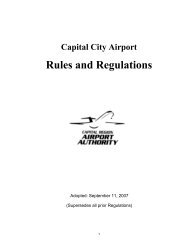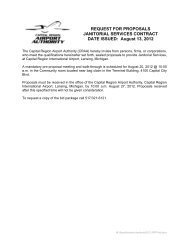Master Plan Update (pdf) - Lansing/Capital City Airport
Master Plan Update (pdf) - Lansing/Capital City Airport
Master Plan Update (pdf) - Lansing/Capital City Airport
Create successful ePaper yourself
Turn your PDF publications into a flip-book with our unique Google optimized e-Paper software.
3.4.2 Runway Analysis<br />
<strong>Capital</strong> Region <strong>Airport</strong> Authority<br />
<strong>Capital</strong> <strong>City</strong> <strong>Airport</strong> <strong>Master</strong> <strong>Plan</strong> <strong>Update</strong><br />
The runway analysis addresses specific requirements relative to the ability of the existing runways<br />
at <strong>Capital</strong> <strong>City</strong> <strong>Airport</strong> to facilitate the projected demand. At a minimum, runways must have the<br />
proper length, width, strength, and prescribed FAA design standards to safely accommodate the<br />
design aircraft for each runway.<br />
3.4.2.1 Runway Length Analysis<br />
Runway length planning analysis was conducted to determine recommended runway length<br />
requirements for various categories of aircraft, as well as for specific aircraft. The physical layout<br />
of <strong>Capital</strong> <strong>City</strong> <strong>Airport</strong> and the operating requirements of the design (or critical) aircraft typically<br />
dictate runway length requirements. The FAA’s <strong>Airport</strong> Design Microcomputer Program was used<br />
as an initial screening tool to determine general runway length requirements for the <strong>Airport</strong>. The<br />
results of this runway length analysis are listed in Table 3-8.<br />
Table 3-8<br />
AIRCRAFT RUNWAY LENGTH REQUIREMENTS<br />
Aircraft Category<br />
Small airplanes (Less than 12,500 lbs.)<br />
100% of fleet (Less than 10 seats)<br />
Small airplanes (Less than 12,500 lbs.)<br />
100% of fleet (10 or more seats)<br />
Large airplanes (Between 12,501 lbs.-60,000 lbs.)<br />
75% of fleet @ 60% Useful Load<br />
75% of fleet @ 90% Useful Load<br />
100% of fleet @ 60% Useful Load<br />
100% of fleet @ 90% Useful Load<br />
Large Airplanes (Greater than 60,000 lbs.)<br />
500 Mile Stage Length<br />
1,000 Mile Stage Length<br />
2,000 Mile Stage Length<br />
3,000 Mile Stage Length<br />
Source: FAA <strong>Airport</strong> Design Microcomputer Program<br />
Recommended Runway<br />
Length<br />
2,590 feet<br />
4,100 feet<br />
4,730 feet<br />
6,010 feet<br />
5,120 feet<br />
7,360 feet<br />
5,310 feet<br />
6,300 feet<br />
8,050 feet<br />
9,480 feet<br />
As shown, the existing runway system at <strong>Capital</strong> <strong>City</strong> <strong>Airport</strong> can generally accommodate 100<br />
percent of small airplanes, 100 percent of large airplanes less than 60,000 pounds at 60 percent<br />
useful load and large airplanes greater than 60,000 pounds with a stage length up to 1,000 miles.<br />
Runway length is normally defined in a manner that provides sufficient length for 90 percent of the<br />
operational fleet on the longest reasonably expected flight stage length. For airports that must<br />
accommodate new service opportunities to the greatest extent practical, such as <strong>Capital</strong> <strong>City</strong><br />
<strong>Airport</strong>, the availability to accommodate new service that would enhance airport revenues and<br />
community services is very important. An extension to Runway 10R/28L from 7,251 feet to 8,000<br />
feet is currently planned in the near term and an ultimate extension to 8,500 feet in the long term.<br />
The following sections analyze the utility of the extension.<br />
Critical Stage Length<br />
The location of <strong>Capital</strong> <strong>City</strong> <strong>Airport</strong> in the midwest United States places the <strong>Airport</strong> within 1,000<br />
miles of numerous markets. Some Florida markets and markets located in the Mountain and<br />
Pacific time zones (generally west of Denver) are over 1,000 miles. The only destination in excess<br />
Facility Requirements 3-11 Final




